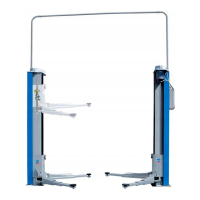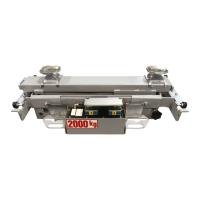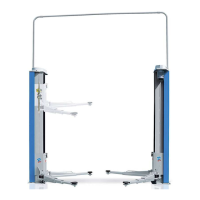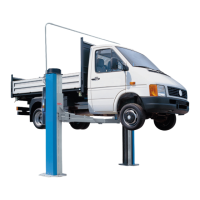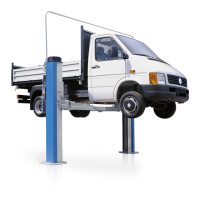23
6
0484-M004-4
6. INSTRUCTIONS POUR L’INSTALLATION
Le pont élévateur doit être installé sur un sol plat et horizontal à
même de soutenir les CHARGES TRANSMISES AU PLAN D’APPUI
(voir gure 1).
6.1 Conditions requises pour l’installation
A) Béton utilisé: catégorie R’bk 300 ou supérieure.
B) Epaisseur minimum du sol sans considérer tout carrelage
éventuel avec son lit de pose (voir gure 1a)
C) L’armature supérieure et inférieure doivent être réalisées au-
moins avec un grillage électrosoudé Ø 4 x150 mm ou équivalent,
dont la maille ne dépasse pas 250 mm. La couverture en béton ne
doit pas excéder les 25 mm
D) Résistance minimale du sol: 1,3 Kg/cm
2
Les caractéristiques que nous venons d’exposer doivent être
garanties sur une surface minimale selon le pont installé (voir tableau
Fig. 1), qui ne doit présenter ni joints de dilatations, ni coupures
pouvant interrompre la continuité de l’armature supérieure.
6. INSTRUCCIONES PARA LA INSTALACIÓN
El elevador debe instalarse sobre un pavimento plano y horizontal
capaz de soportar las CARGAS TRANSMITIDAS AL PLANO DE
APOYO (ver Fig.1).
6.1 Requisitos para la instalación
A) Hormigón empleado: clase R’bk 300 o superior.
B) Espesor mínimo del piso sin considerar los posibles revestimientos
de baldosas y relativa capa de asiento (ver Fig.1a)
C) Armadura superior e inferior realizada con red electrosoldada
Ø 4x150 mm o asimilable, con malla no superior a 250 mm. Espesor
del hormigón no superior a 25 mm
D) Capacidad de carga mínima del suelo: no inferior a 1,3 Kg/cm
2
Las características arriba mencionadas deben estar garantizadas
para una superz mínima según el puente instalado (ver tabla en
la gura 1), el la que no se encuentren juntas de dilatación o cortes
que interrumpan la continuidad de la armadura superior.
6. INSTALLATIONSANWEISUNGEN
Die Hebebühne muss auf einem ebenen und waagrechten Boden
installiert werden, der in der Lage ist, AUF DIE AUFLAGEFLÄCHE
ÜBERTRAGENE BELASTUNGEN (Siehe Abb. 1).
6.1 Installationsanforderungen
A) Beton: Klasse R’bk 300 oder höhere
B) Mindeststärke des Bodenbelags, ohne Rücksicht auf eine evtl.
Fliesenverkleidung und entsprechenden Unterbeton (siehe Abb.1a)
C) Obere und untere Armierung mindestens mit elektrogeschweisstem
Netz Ø 4/150 mm oder ähnlichem ausgeführt, Raster max. 250 mm.
Betonstärke bis zum Eisengerüst max. 25 mm
D) Mindestbelastbarkeit des Bodens 1,3 Kg/cm
2
Die angegebenen Eigenschaften müssen auf einer Mindestäche
nach der Brücke installiert (siehe Tabelle in Abb. 1) garantiert werden,
auf der keinerlei Dehnungsfugen oder Risse vorhanden sein dürfen,
die die Kontinuität der oberen Armierung unterbrechen würden.
6. INSTALLATION INSTRUCTIONS
The lift should be installed on at level oor able to support LOADS
TRANSMITTED TO SUPPORT AREA (See g. 1).
6.1 Installation requirements
Minimum features foor oor should be the following:
A) Concrete used: class R’bk 300 or higher
B) Minimum thickness of the ooring net of any tiling and layout
blocks (See g. 1a)
C) Upper and lower reinforcement done at least with electro-welded
wire net Ø 4x150 mm or combined, and mesh not exceeding 250
mm. Wire cover no greater than 25 cm
D) Bearing capacity of area no less than 1,3 Kg/cm
2
These characteristics must be guaranteed over a minimum area
dependent lift installed (see the table in g.1), where there must
be no expansion joints or cuts to break the continuity of the upper
reinforcement
6. ISTRUZIONI PER L’INSTALLAZIONE
Il sollevatore deve essere installato su pavimento piano e orizzontale
in grado di reggere i CARICHI TRASMESSI AL PIANO D’APPOGGIO
(vedi g. 1).
6.1 Requisiti per l’installazione
Le caratteristiche di minima della pavimentazione debbono essere:
A) Calcestruzzo utilizzato: classe R’bk 300 o superiore
B) Spessore minimo della pavimentazione al netto di eventuale
piastrellatura e relativo massetto di posa (vedi g. 1a)
C) Armatura superiore ed inferiore realizzata almeno con rete
elettrosaldata Ø 4 x 150 mm o assimilabile, e maglia non superiore
a 250 mm. Copriferro non maggiore di 25 mm
D) Portanza del terreno non minore di 1,3 Kg/cm
2
Le suddette caratteristiche devono essere garantite su un’area
minima dipendente dal ponte installato (cfr. tabella di g.1), e nella
quale non devono essere presenti giunti di dilatazione o tagli che
interrompano la continuità dell’armatura superiore.
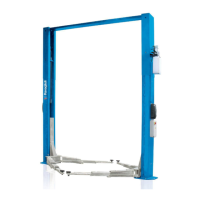
